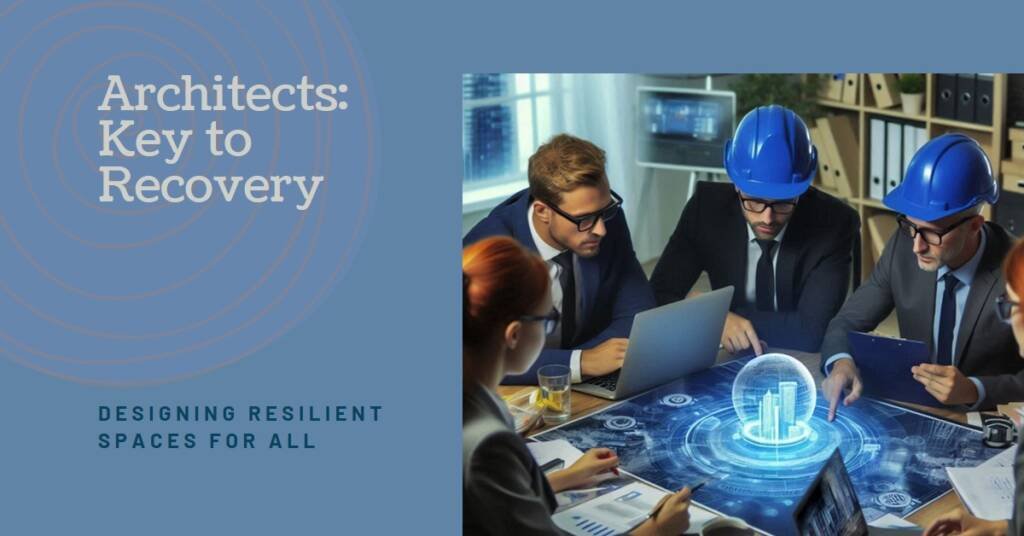
Table of Contents
- Introduction to Disaster Recovery
- The Architect’s Unique Skill Set
- Architects as Collaborators in Recovery Efforts
- Designing Resilient Structures
- Case Studies of Successful Architect-Led Recoveries
- Community Engagement and Empowerment
- The Future of Architectural Practice in Disaster Recovery
- Challenges Faced by Architects During Recovery
- Conclusion
Introduction to Disaster Recovery
Disaster recovery encompasses the strategies and actions taken to restore a community or organization following a catastrophic event. This process is crucial not only for the immediate response to a disaster but also for long-term recovery and resilience. Effective disaster recovery planning is essential to mitigate the adverse effects of disasters, which can range from natural calamities such as hurricanes and earthquakes to human-made crises like industrial accidents or acts of terrorism. Comprehensive response strategies are vital for protecting lives, safeguarding infrastructure, and preserving economic stability.
The importance of planning in disaster recovery cannot be overstated. A well-structured recovery plan helps ensure that communities can quickly respond to emergencies and restore essential services in the aftermath. Such planning involves coordination among various stakeholders, including government agencies, non-profit organizations, and private sector entities. Each player has a role in maintaining community resilience and ensuring that recovery efforts are comprehensive and inclusive. By addressing the physical, social, and economic aspects of recovery, communities can emerge stronger and more resilient than before.
The impact of effective disaster recovery extends beyond immediate relief efforts. A transparent and well-executed recovery strategy has the potential to foster community cohesion and rebuild trust among residents. It can also ensure that critical infrastructure, such as transportation networks and utilities, is reinforced against future disasters. Furthermore, the economic implications of efficient recovery cannot be understated; businesses that swiftly recover contribute to a quicker economic rebound. Ultimately, the strategy undertaken for disaster recovery serves as a blueprint for future preparedness and resilience, emphasizing the significance of planning and response in safeguarding communities against the unpredictable nature of disasters.
The Architect’s Unique Skill Set
The role of architects extends far beyond mere design; their unique skill set equips them with the capabilities necessary for effective disaster recovery. One of the pivotal skills that architects bring to the table is design thinking. This method encourages a holistic approach to problem-solving, enabling architects to analyze complex situations thoroughly and propose innovative solutions that consider both practicalities and aesthetics. This ability to envision comprehensive designs is essential during the recovery phase, as the need arises to rebuild communities that may have suffered extensive damage.
In addition to design thinking, architects possess robust problem-solving skills. They are trained to identify potential challenges and develop strategic responses, an essential attribute when addressing the unpredictable nature of disaster recovery. For instance, architects may need to overcome logistical hurdles, adapt structures to withstand future calamities, or integrate new technologies into rebuilding efforts. Their training enables them to evaluate various options and select the most appropriate course of action, which is invaluable in time-sensitive scenarios following a disaster.
Furthermore, project management is another crucial skill that architects emulate. In the aftermath of a disaster, a multitude of stakeholder interests—including community members, local governments, and construction teams—must be coordinated. Architects can navigate these interests effectively, ensuring that the project remains within budget and timeline constraints. Their comprehensive understanding of local codes and regulations is equally important, as compliance with these standards is vital for the safety and integrity of reconstructed buildings and infrastructures.
Overall, the diverse skills that architects possess—ranging from design thinking and problem-solving to project management—are instrumental during the disaster recovery process. Their ability to adapt these skills in a collaborative environment contributes significantly to rebuilding efforts, ultimately fostering communities that are more resilient to future challenges.
Architects as Collaborators in Recovery Efforts
In the realm of disaster recovery, architects play a pivotal role not only as designers but also as essential collaborators who facilitate the rebuilding process. Their expertise extends beyond creating aesthetically pleasing structures; they serve as strategic advisors to government agencies, non-governmental organizations (NGOs), and local communities, ensuring that recovery efforts are both effective and efficient. This collaborative nature of architects is critical during the various phases of rebuilding after a disaster strikes.
Firstly, architects assist in assessing the needs of affected communities. When a disaster occurs, immediate evaluations are necessary to understand the specific challenges individuals face. Architects engage with local stakeholders, including residents and community leaders, to gather insights on what is required. This initial phase is fundamental for ensuring that the recovery efforts align with the needs and aspirations of the community, rather than imposing top-down solutions that may not resonate with the inhabitants.
Secondly, architects work alongside government agencies and NGOs to develop comprehensive recovery plans. These plans must consider multiple factors including infrastructure, environmental sustainability, and social dynamics. By collaborating with these entities, architects can incorporate a more holistic approach to recovery efforts, ensuring that new constructions not only meet immediate needs but are also resilient against future disasters. Their ability to integrate various disciplines—such as engineering, urban planning, and environmental science—further enhances the effectiveness of these plans.
Finally, architects play a crucial role in the implementation of recovery solutions. They often lead teams of construction professionals, ensuring that the plans are executed with the highest standards of quality and safety. Throughout this process, architects remain adaptable, ready to address any emerging challenges, thus reinforcing their value as key collaborators in disaster recovery efforts.
Designing Resilient Structures
The role of architects is pivotal in creating buildings that not only withstand disaster impacts but also contribute to effective recovery efforts. Resilient design principles focus on enhancing sustainability and ensuring the longevity of structures in the face of evolving climate challenges. By integrating sustainable design strategies, architects can significantly influence how structures perform during and after disasters. This includes thoughtful site selection, orientation, and the utilization of energy-efficient systems that minimize environmental impact.
A key component in designing for resilience is the selection of materials. Architects often advocate for the use of durable, locally-sourced materials that are better suited for the specific environmental conditions of the site. These materials can withstand extreme weather events and reduce environmental footprints, which is vital in the aftermath of disasters. Moreover, the incorporation of innovative materials designed to absorb shock or resist decay can enhance a building’s overall resilience.
Adaptive reuse of existing structures is another strategy architects employ to bolster disaster recovery. Rather than demolishing damaged buildings, architects often redesign and retrofit them to serve new purposes or improve their resistance to future disasters. This approach not only conserves resources and funding but also preserves cultural heritage and community identity, which can be invaluable in the recovery process.
Incorporating these principles not only mitigates the impact of future disasters but also fosters communities that are better prepared and equipped to face challenges. Ultimately, the comprehensive understanding of resilience in design allows architects to contribute significantly to disaster recovery efforts while promoting sustainable practices. It is through these concerted efforts that communities can rebuild effectively, ensuring their livelihoods are safeguarded against the increasingly unpredictable nature of disasters.
Case Studies of Successful Architect-Led Recoveries
Architects have historically played a vital role in disaster recovery efforts, often serving as leaders in the rebuilding process and community resilience initiatives. Their expertise goes beyond aesthetics and structure; they are integral in creating safe, functional, and sustainable environments after a disaster strikes. One such case study is the post-Hurricane Katrina recovery efforts in New Orleans, where architects collaborated with local communities to redesign neighborhoods that had been devastated. These professionals not only addressed immediate rebuilding needs but also incorporated flood-resistant designs, ensuring that future developments would be more resilient to similar threats.
Another notable example is the 2010 Haiti earthquake, which led to widespread devastation. Architects engaged in the recovery were tasked with not only rebuilding homes and infrastructure, but also rethinking urban planning. These projects emphasized local materials and labor, ultimately fostering economic resilience and encouraging community involvement in the rebuilding process. The integration of sustainable practices, such as the use of traditional construction methods, significantly impacted the efficiency of the recovery efforts.
Further illustrating the essential role that architects play, the rebuilding efforts following the 2004 Indian Ocean tsunami offered designed solutions that have become models for future projects. Architects played a critical role in designing communities that could withstand natural disasters, enhancing their resilience. By implementing strict building codes and developing early warning systems in conjunction with infrastructure upgrades, the architectural community significantly contributed to the overall recovery and safety of these coastal areas.
In conclusion, the impact of architects on disaster recovery is profound and multifaceted, as demonstrated by these case studies. Through their innovative designs and commitment to community engagement, architects help rebuild not only physical structures but also the hopes and dreams of affected communities, paving the way for a more resilient future.
Community Engagement and Empowerment
Community engagement is a fundamental component of disaster recovery, playing a crucial role in the effectiveness and sustainability of rebuilding efforts. Architects, as pivotal figures in this process, can significantly enhance community participation in the design and decision-making stages of recovery. By directly involving residents, architects can better understand the specific needs, values, and culture of the community, thereby fostering a sense of ownership over recovery initiatives.
One of the primary approaches architects can employ is to conduct participatory design workshops. These workshops are forums where community members can express their concerns, preferences, and aspirations for rebuilding their neighborhoods. Through interactive activities, such as brainstorming sessions and visualizations, participants are invited to contribute ideas that align with their vision for the future. This process not only empowers residents but also ensures that the architectural solutions developed are contextually relevant and culturally sensitive.
Furthermore, empowering communities extends beyond design participation; it involves equipping individuals with the knowledge and skills necessary for engagement throughout the recovery process. Architects can collaborate with local organizations to offer training sessions focused on community planning, sustainable design practices, and advocacy skills. By developing these competencies, community members are better prepared to take an active role in discussions regarding rebuilding efforts and are able to advocate effectively for their interests.
Establishing long-term partnerships with local stakeholders is another essential strategy. Architects can work with community leaders, government agencies, and non-profit organizations to create frameworks for ongoing dialogue and collaboration. Such partnerships can facilitate a collective vision for development, ensuring that recovery efforts are not only responsive but also sustainable in the long run. Ultimately, through community engagement and empowerment, architects play an indispensable role in shaping resilient environments that reflect the lived experiences and aspirations of the communities they serve.
The Future of Architectural Practice in Disaster Recovery
As the frequency and intensity of disasters increase due to climate change and urbanization, the architectural practice has begun to evolve in response to the pressing need for effective disaster recovery strategies. Emerging trends in this field reflect a growing integration of technology, innovative materials, and data analysis, thus reshaping the way architects approach recovery efforts. The use of predictive analytics and geographic information systems (GIS) allows architects to foresee potential disaster impacts and develop preemptive strategies, ultimately leading to more resilient communities.
One key area of innovation is the application of advanced construction materials that can withstand extreme conditions and enhance structural integrity. For instance, the utilization of sustainable materials such as bamboo and recycled composites not only contribute to environmental preservation but also offer durability and flexibility in design. These materials are particularly beneficial in regions that frequently encounter earthquakes or floods, allowing for rapid rebuilding without compromising safety.
Furthermore, technology has facilitated the development of digital modeling and simulation tools that empower architects to visualize and plan for various recovery scenarios. By creating virtual models of affected areas, architects can experiment with different designs and layouts to find solutions that maximize the effectiveness of the recovery process. The participation of local communities in these simulations ensures that the needs and preferences of those affected are incorporated into the architectural solutions, enhancing overall satisfaction and efficacy.
Additionally, collaboration among architects, engineers, urban planners, and local governments is becoming increasingly vital. This multidisciplinary approach fosters innovation and leads to comprehensive recovery plans that address both the immediate and long-term needs of communities. As architects navigate the complexities of disaster recovery, the integration of forward-thinking strategies and technologies will undoubtedly shape the landscape of architectural practice in the coming years.
Challenges Faced by Architects During Recovery
The role of architects in disaster recovery is fundamentally crucial, yet it is fraught with numerous challenges that can impede effective response and rebuilding efforts. One significant hurdle is the limitation of funding. After a disaster, financial resources are often scarce and must be allocated across various recovery initiatives. Architects must navigate budget constraints, sourcing adequate funding for projects, and demonstrating the value of their work to secure necessary investments. This financial pressure can lead to compromises in design quality or the scope of rebuilding efforts, ultimately affecting the resilience and sustainability of the rebuilt structures.
Another challenge that architects frequently encounter is the complex bureaucracies present within local governments. Navigating the regulatory landscape can be cumbersome and time-consuming, particularly in the aftermath of a disaster when urgency is paramount. Architects must not only comply with myriad local building codes but also coordinate with multiple agencies that may have overlapping interests and objectives. This bureaucratic entanglement can delay critical decisions and prolong recovery processes, hindering the architects’ ability to implement effective solutions promptly.
Additionally, architects are often faced with the need to address the diverse requirements of affected populations. Each community and individual will have unique needs and expectations for the spaces they inhabit. Architects must engage in meaningful consultations with stakeholders, ensuring that their designs reflect the cultural, social, and emotional contexts of the communities they serve. Balancing these varying needs while adhering to technical constraints and financial limitations significantly complicates their role in disaster recovery. Collectively, these challenges underscore the multifaceted nature of the architect’s responsibilities during recovery, necessitating innovative thinking and collaborative approaches to overcome obstacles effectively.


Conclusion
The role of architects in disaster recovery is not merely functional; it is transformative. Their expertise extends far beyond the physical construction of buildings and infrastructure; it encompasses a holistic approach that includes the well-being of affected communities. Architects are crucial in ensuring that rebuilding efforts enhance the resilience of communities facing the threat of future disasters. By integrating sustainable practices and innovative design solutions, they contribute to creating environments that withstand such adversities more effectively.
Moreover, architects play a significant part in collaborative efforts with local authorities, engineers, urban planners, and residents. This interdisciplinary approach enables them to incorporate community needs and cultural contexts into their designs, fostering a sense of ownership and belonging among locals. Their engagement often leads to the creation of spaces that not only serve as shelters during emergencies but also improve the quality of life for inhabitants in the long term. For instance, well-planned public spaces can act as gathering points for community support during crises.
Additionally, architects are instrumental in advocating for policies that prioritize disaster preparedness and resilience. They help shape building codes and community planning guidelines that can significantly reduce vulnerabilities in future events. Through education and outreach, architects raise awareness about disaster risks, helping communities to foster a proactive mindset towards disaster mitigation. Ultimately, it is their vision, creativity, and commitment to sustainable development that leave a lasting impact on communities, ensuring not only their physical recovery but also their psychological and social regeneration.



